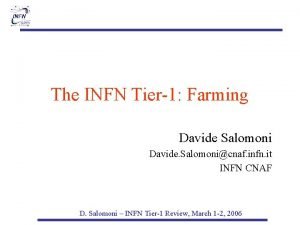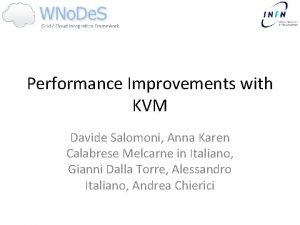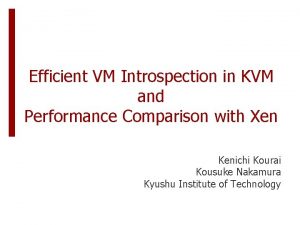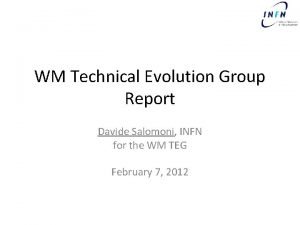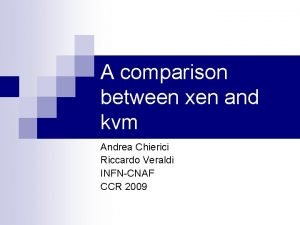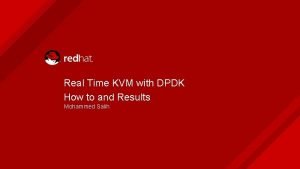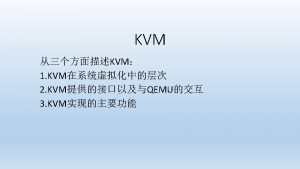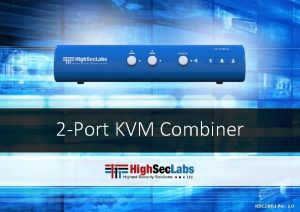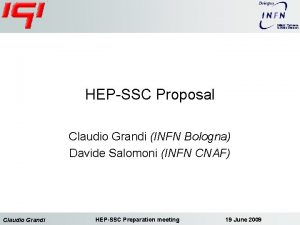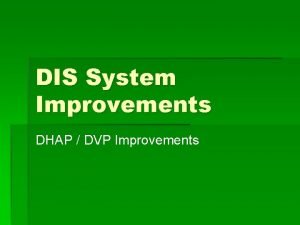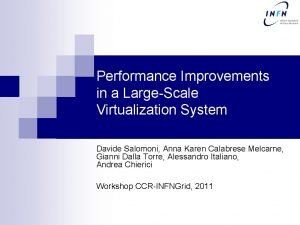Performance Improvements with KVM Davide Salomoni Anna Karen
















- Slides: 16

Performance Improvements with KVM Davide Salomoni, Anna Karen Calabrese Melcarne in Italiano, Gianni Dalla Torre, Alessandro Italiano, Andrea Chierici

Alternatives to mounting GPFS on VMs • Preliminary remark: the distributed file system adopted by the INFN Tier-1 is GPFS – • – – 2 Serving about 8 PB of disk storage directly, and transparently interfacing to 10 PB of tape storage via INFN ’s GEMSS (an MSS solution based on Sto. RM/GPFS) The issue, not strictly GPFS-specific, is that any CPU core may become a GPFS (or any other distributed FS) client. This leads to GPFS clusters of several thousands of nodes (WNo. De. S currently serves about 2, 000 VMs at the INFN Tier-1) – GPFS-based Storage This is large, even according to IBM, requires special care and tuning, and may impact performance and functionality of the cluster This will only get worse with the steady increase in the number of CPU cores in processors We investigated two alternatives, both assuming that an HV would distributed data to its own VMs • sshfs, a FUSE-based solution • a GPFS-to-NFS export VM (GPFS) Hypervisor (no GPFS) VM (sshfs) Hypervisor ({sshfs, nfs}-to-GPFS) GPFS-based Storage

sshfs vs. nfs: throughput • • sshfs throughput constrained by encryption (even with the lowest possible encryption level) Marked improvement (throughput better than nfs) using sshfs with no encryption through socat, esp. with some tuning – File permissions are not straightforward with socat, though (*) socat options: direct_io, no_readahead, sshfs_sync GPFS on VMs (current setup) 3

sshfs vs. nfs: CPU usage Write GPFS on VMs (current setup) (*) socat options: direct_io, no_readahead, sshfs_sync Overall, socatbased sshfs w/ appropriate options seems the best performer Read GPFS on VMs (current setup) 4

sshfs vs. nfs Conclusions • • An alternative to direct mount of GPFS filesystems on thousands of VMs is available via hypervisor-based gateways, distributing data to VMs Overhead, due to the additional layer in between, is present. Still, with some tuning it is possible to get quite respectable performance – sshfs, in particular, performs very well, once you take encryption out. But one needs to be careful with file permission mapping between sshfs and GPFS, • Watch for VM-specific caveats – For example, WNo. De. S supports hypervisors and VMs to be put in multiple VLANs (VMs themselves may reside in different VLANs) • Support for sshfs or nfs gateways is scheduled to be included in WNo. De. S 2 “Harvest” • Virt. FS (Plan 9 folder sharing over Virtio - I/O virtualization framework)investigation in the future, but native support by RH/SL currently missing 5

VM-related Performance Tests • Preliminary remark: WNo. Des uses KVM-based VMs, exploiting the KVM -snapshot flag – – • Tests performed: – SL 6 vs SL 5 • Classic HEP-Spec 06 for CPU performance • Iozone for local I/O – Network I/O: • virtio-net has been proven to be quite efficient (90% or more of wire speed) • We tested SR-IOV (not shown in this presentation) Disk caching is (should have been) disabled in all tests – • Local I/O has typically been a problem for VMs – – 6 This allows us to download (via either http or Posix I/O) a single read-only VM image to each hypervisor, and run VMs writing automatically purged delta files only. This saves substantial disk space, and time to locally replicate the images We do not run VMs stored on remote storage - at the INFN Tier-1, the network layer is stressed out enough by user applications WNo. De. S not an exception, esp. due to its use of the KVM -snapshot flag The next WNo. De. S release will still use -snapshot, but for the root partition only; /tmp and local user data will reside on a (host-based) LVM partition

Test set-up • HW: 4 x Intel E 5420, 16 GB RAM, 2 x 10 k rpm SAS disk using a LSI Logic RAID controller • SL 5. 5: kernel 2. 6. 18 -194. 32. 1. el 5, kvm-83 -164. el 5_5. 9 • SL 6: kernel 2. 6. 32 -71. 24. 1, qemu-kvm-0. 12. 1. 2 -2. 113 • iozone: iozone -Mce -I -+r -r 256 k -s <2 x. RAM>g -f <filepath> -i 0 -i 1 -i 2 7

HS 06 on Hypervisors and VMs (E 5420) Physical Machine - SL 5. 5 vs RHEL 6 vs SL 6 80 70 HEP-SPEC 06 60 50 40 30 20 10 0 1 4 SL 5. 5 8 8 # of instances Rhel 6 sl 6 12

HS 06 on Hypervisors and VMs (E 5420) SL 5. 5 phys vs virtual, HEP-SPEC 06 80 70 HEP-SPEC 06 60 50 40 30 20 10 0 1 4 SL 5. 5 9 # of parallel VMs sl 5. 5 su sl 6 8 sl 5. 5 su sl 6 ept=0 12

HS 06 on Hypervisors and VMs (E 5420) • Slight performance increase of SL 6 vs. SL 5. 5 on the hypervisor – Around +3% (exception made for 12 instances: -4%) • Performance penalty of SL 5. 5 VMs on SL 5. 5 HV: -2. 5% • Unexpected performance loss of SL 5. 5 VMs on SL 6 vs. SL 5. 5 HV – ept — Extended Page Tables, an Intel feature to make emulation of guest page tables faster. 10

iozone on SL 5. 5 (SL 5. 5 VMs) • • iozone tests with caching disabled, file size 4 GB on VMs with 2 GB RAM host with SL 5. 5 taken as reference VM on SL 5. 5 with just -snapshot crashed Based on these tests, WNo. De. S will support -snapshot for the root partition and a (dynamically created) native LVM partition for /tmp and for user data – 11 A per-VM single file or partition would generally perform better, but then we’d practically lose VM instantiation dynamism

iozone on SL 6 (SL 5. 5 VMs) Consistently with what was seen with some CPU performance tests, iozone on SL 6 surprisingly performs often worse than on SL 5. 5 Assuming RHEL 6 performance will be improved by RH, using VM with -snapshot for the root partition and a native LVM patition for /tmp and user data in WNo. Des seems a good choice here as well • • – But we will not upgrade HVs to SL 6 until we are able to get reasonable results in this area VMs lvm and snap, on SL 5 host VMs lvm and snap, on sl 6 host 250000 200000 k. B/sec 200000 150000 100000 50000 0 0 write 12 150000 rewrite read reread rand write host sl 6 2 concurrent VMs host SL 5 2 concurrent VMs 4 concurrent VMs 8 concurrent VMs

iozone on QCOW 2 image file VMs with QCOW 2 image Adoption of qcow 2 images is suggested only if preallocating the image metadata 250000 200000 k. B/s 150000 100000 50000 0 write vm sl 5 qcow 13 rewrite read reread rand read vm sl 5 qcow 2 nd run host sl 6 rand write host SL 5

The problem we see for the future • Number of cores in modern CPUs is constantly increasing • Virtualizing to optimize (cpu/ram) resources is not enough – O(20) cores per cpu may require 10 GBps nics (at least at T 1) – Disk I/O is still a problem (it was the same last year, no significant improvement has been done) 14

Technology improvements • SSDs may help – Testing now – Great expectations, but price will prevent massive adoption at least in 2011 • SL 6: virtualization oriented – KSM, hugetlbfs, pci-passthrough – Still problems with performance • KVM Virt. FS: para-virtualized FS 15

Conclusions • VM performance tuning still requires detailed knowledge of system internals and sometimes of application behaviors • The steady increase in the number of cores per physical hardware has a significant impact in the number of virtualized systems even on a mediumsized farm – This is important both for access to distributed storage, and for the set-up of traditional batch system clusters (e. g. the size of a batch farm easily increases by an order of magnitude with VMs). 16
 Davide salomoni
Davide salomoni Sshfs performance
Sshfs performance Kvm vs xen
Kvm vs xen Alessandra salomoni
Alessandra salomoni Alessandra salomoni
Alessandra salomoni Wm evolution
Wm evolution Alessandra salomoni
Alessandra salomoni Extreme spbm
Extreme spbm Ovirt vs kvm
Ovirt vs kvm Xen vs kvm
Xen vs kvm Kvm gpu acceleration
Kvm gpu acceleration Kvm dpdk
Kvm dpdk Improvements roadmap
Improvements roadmap Improvements and betterments insurance
Improvements and betterments insurance Direct improvements
Direct improvements Pughs tires
Pughs tires Medicare improvements for patients and providers act
Medicare improvements for patients and providers act
